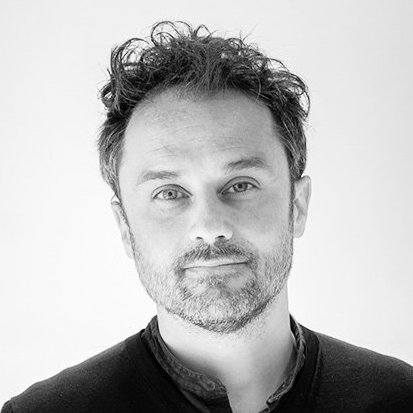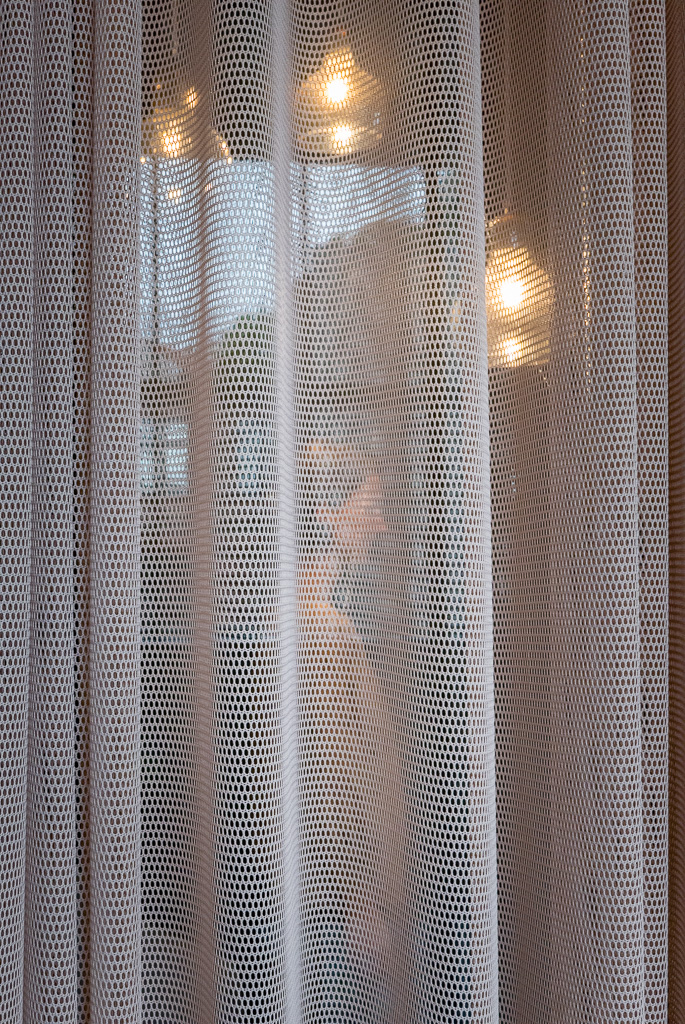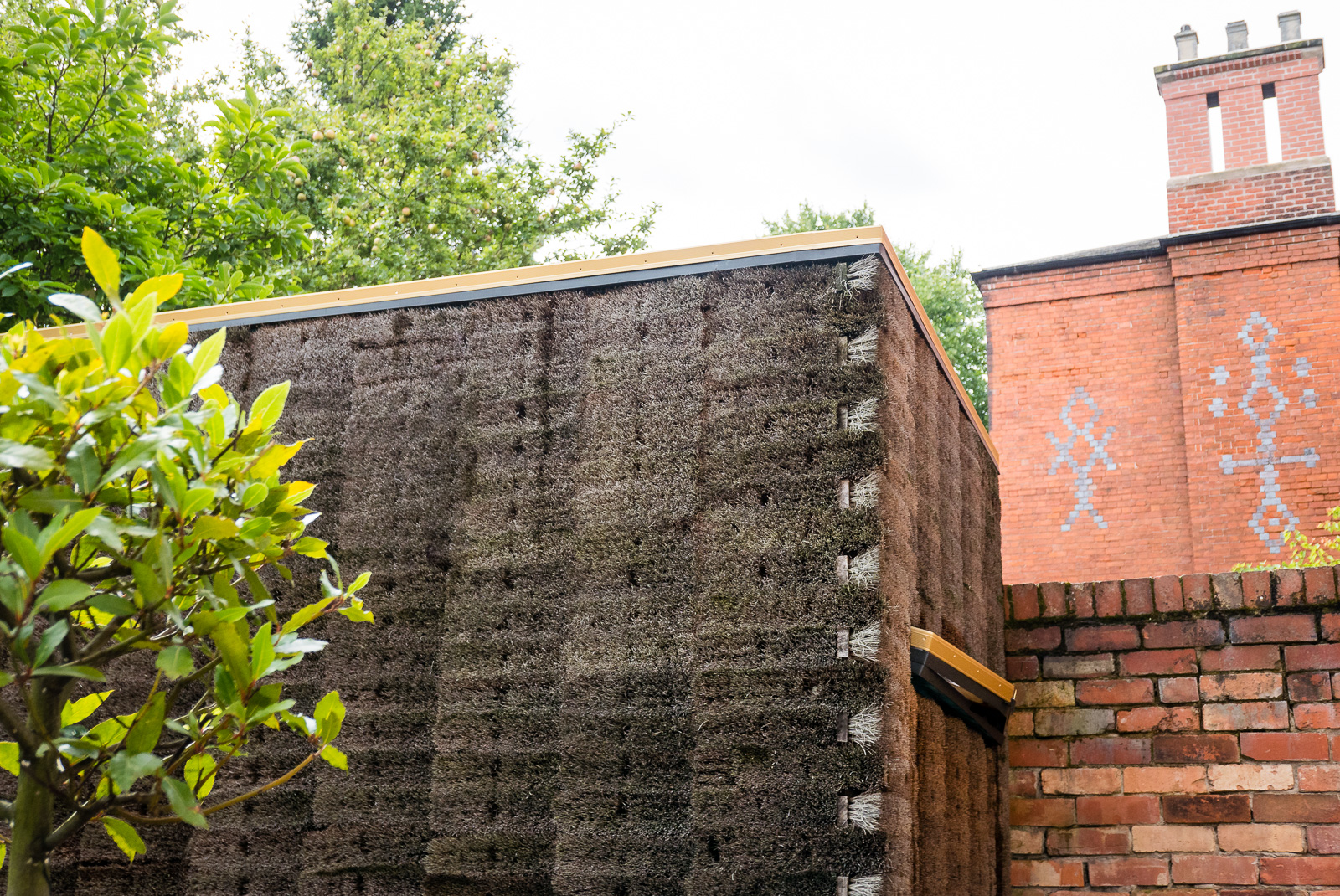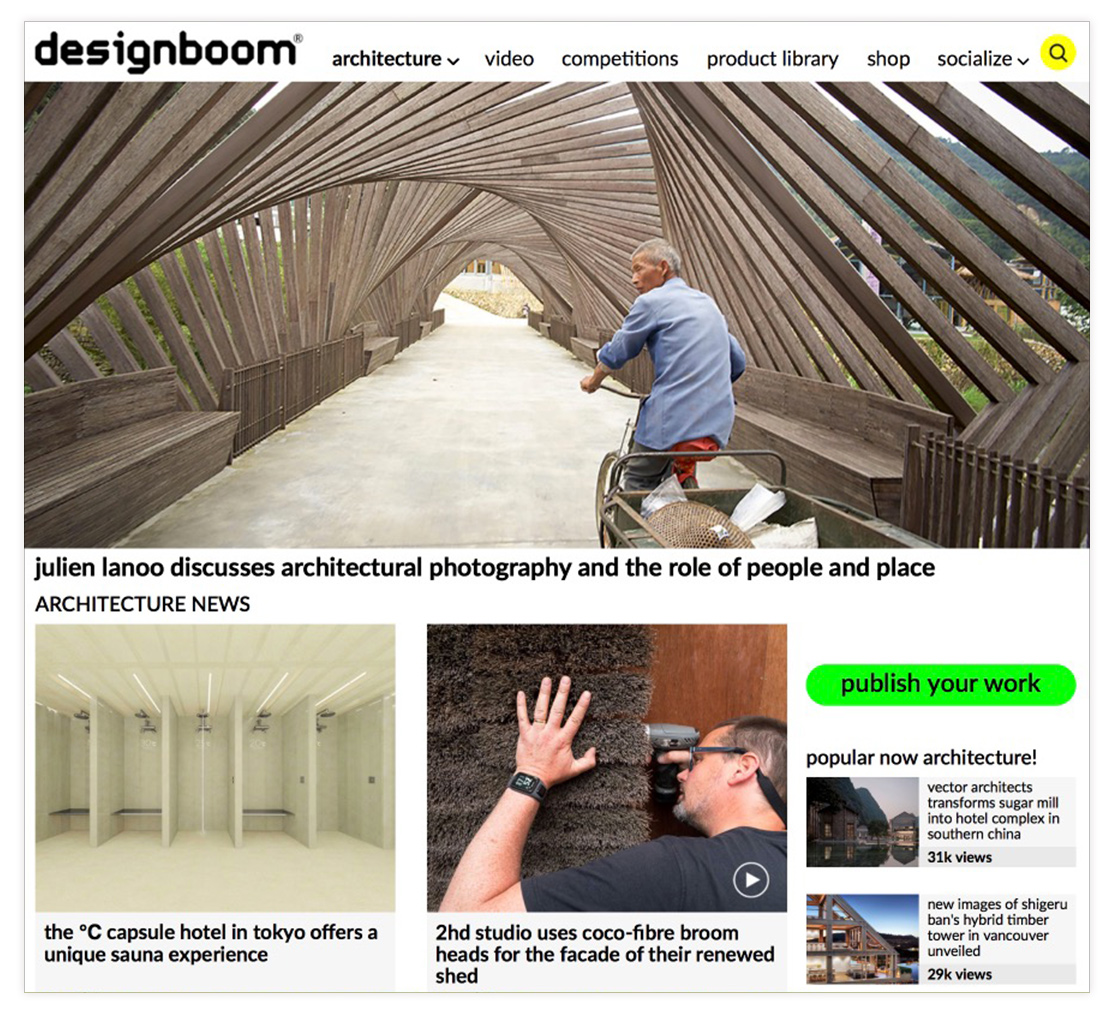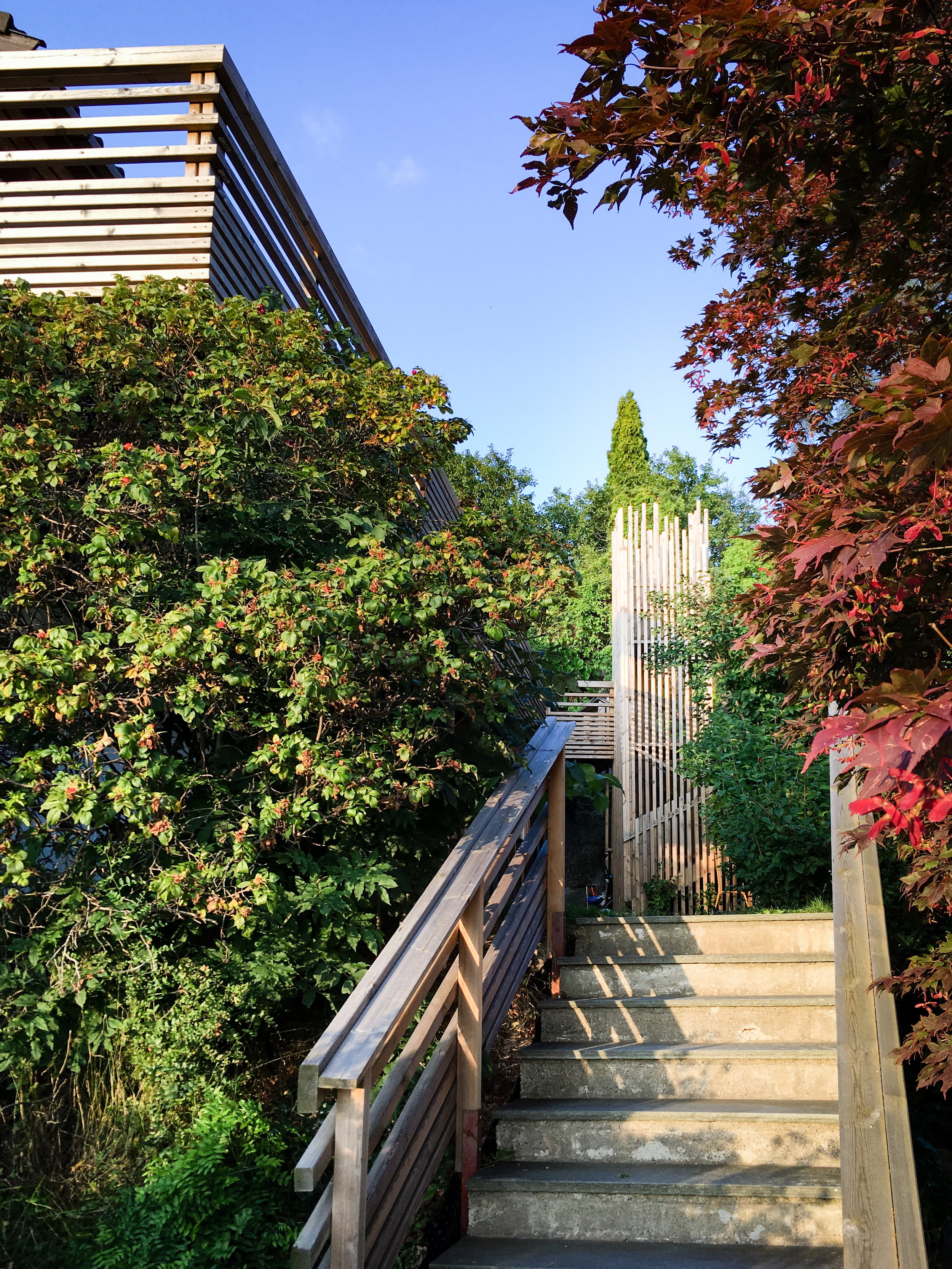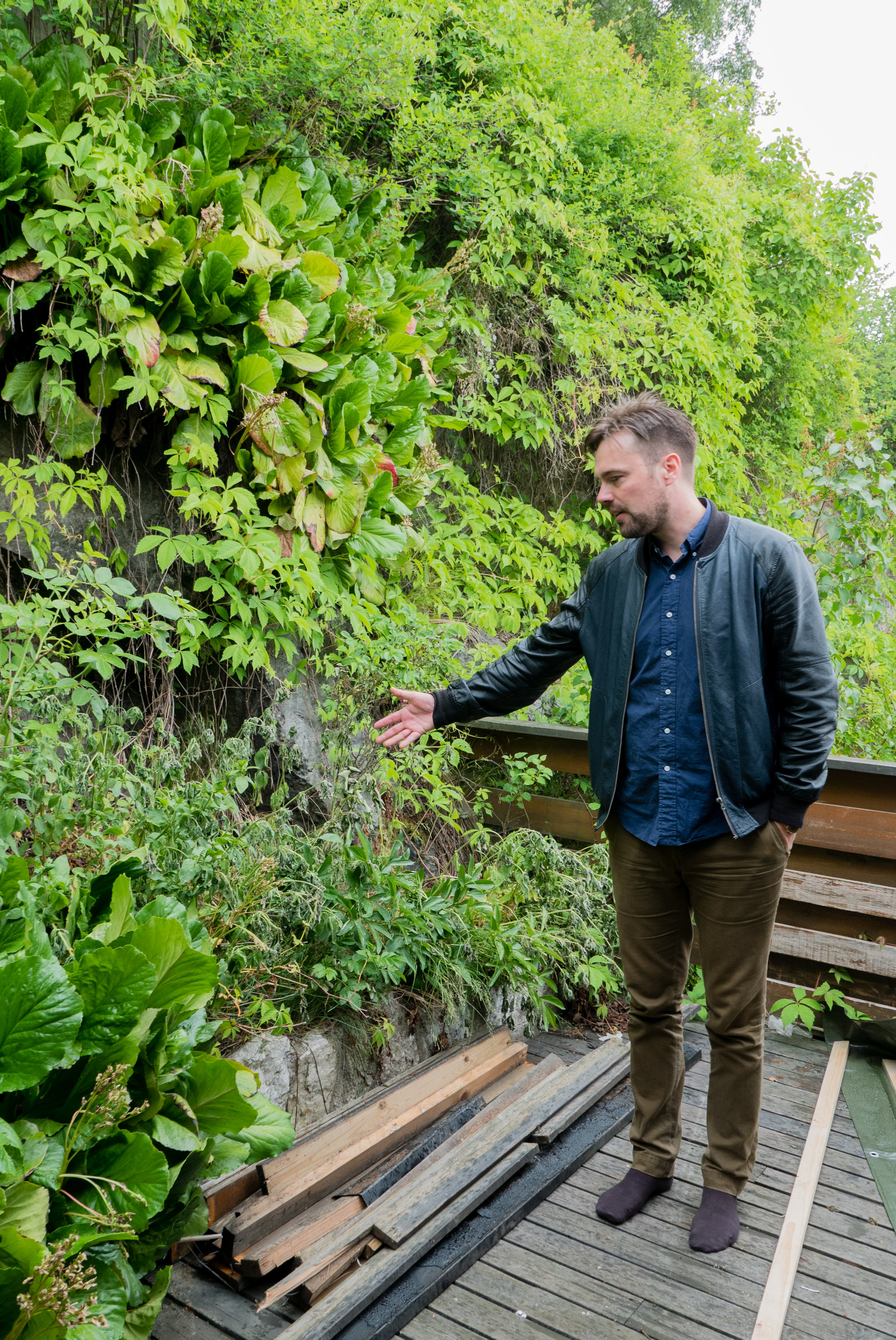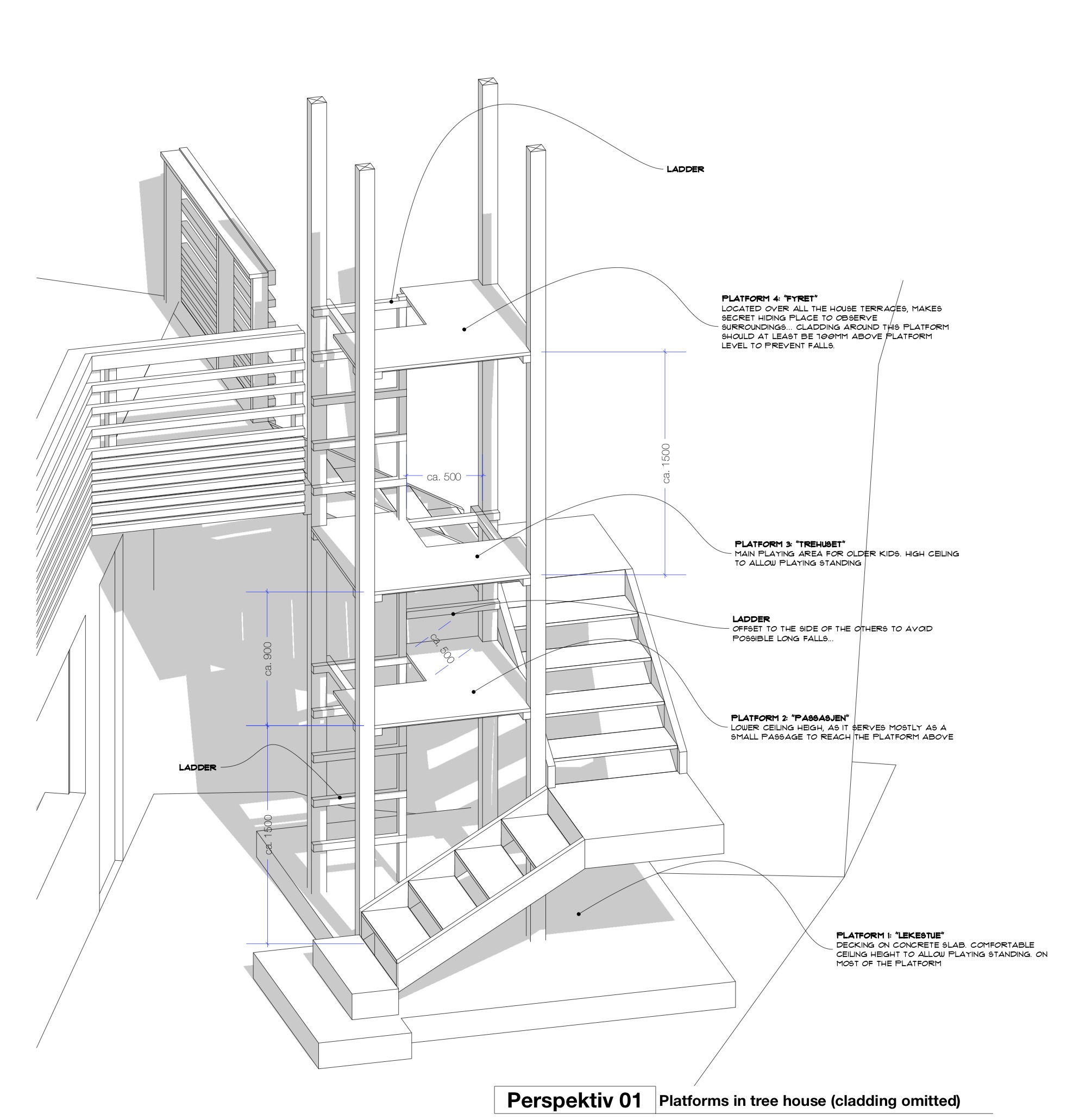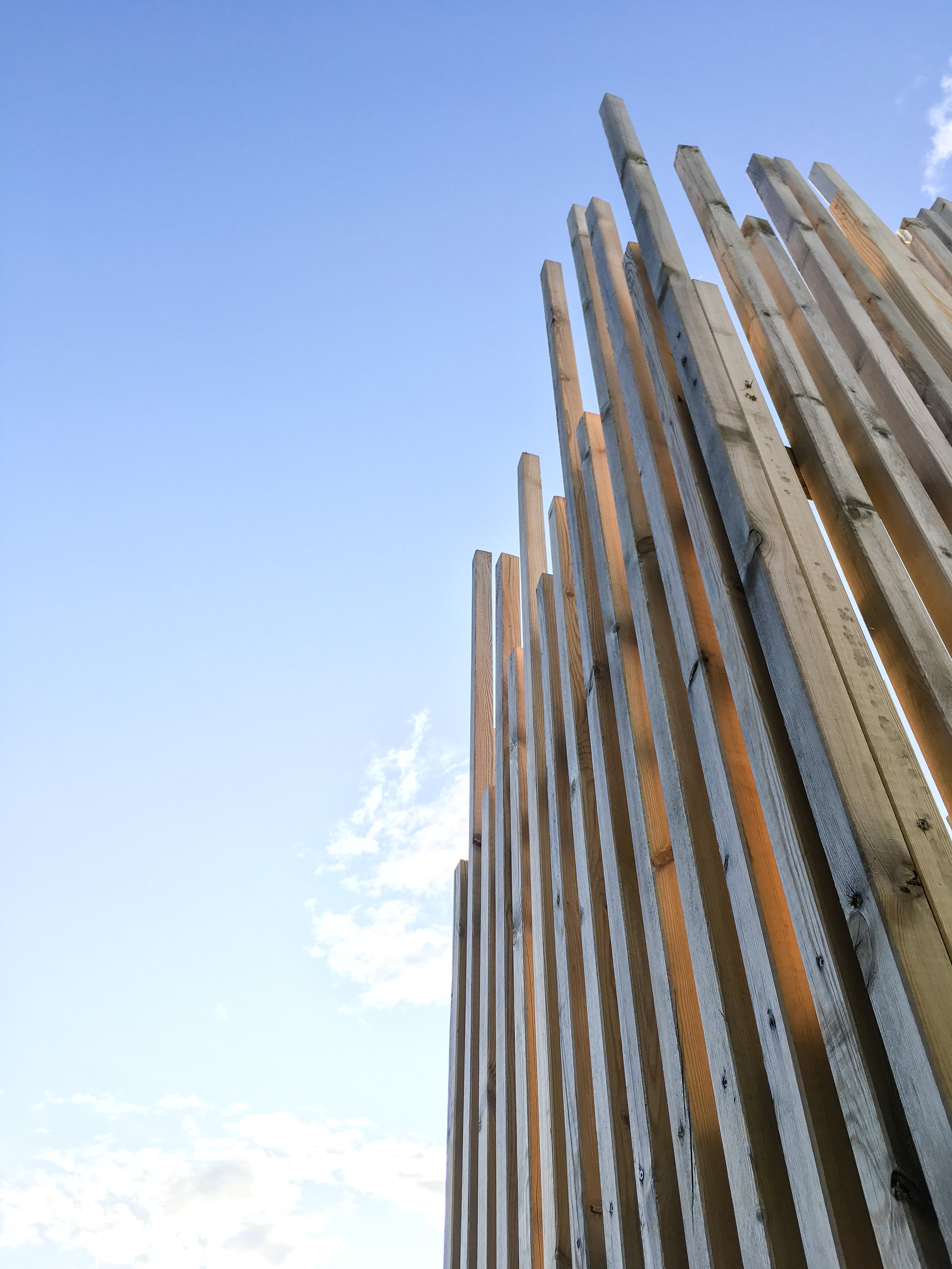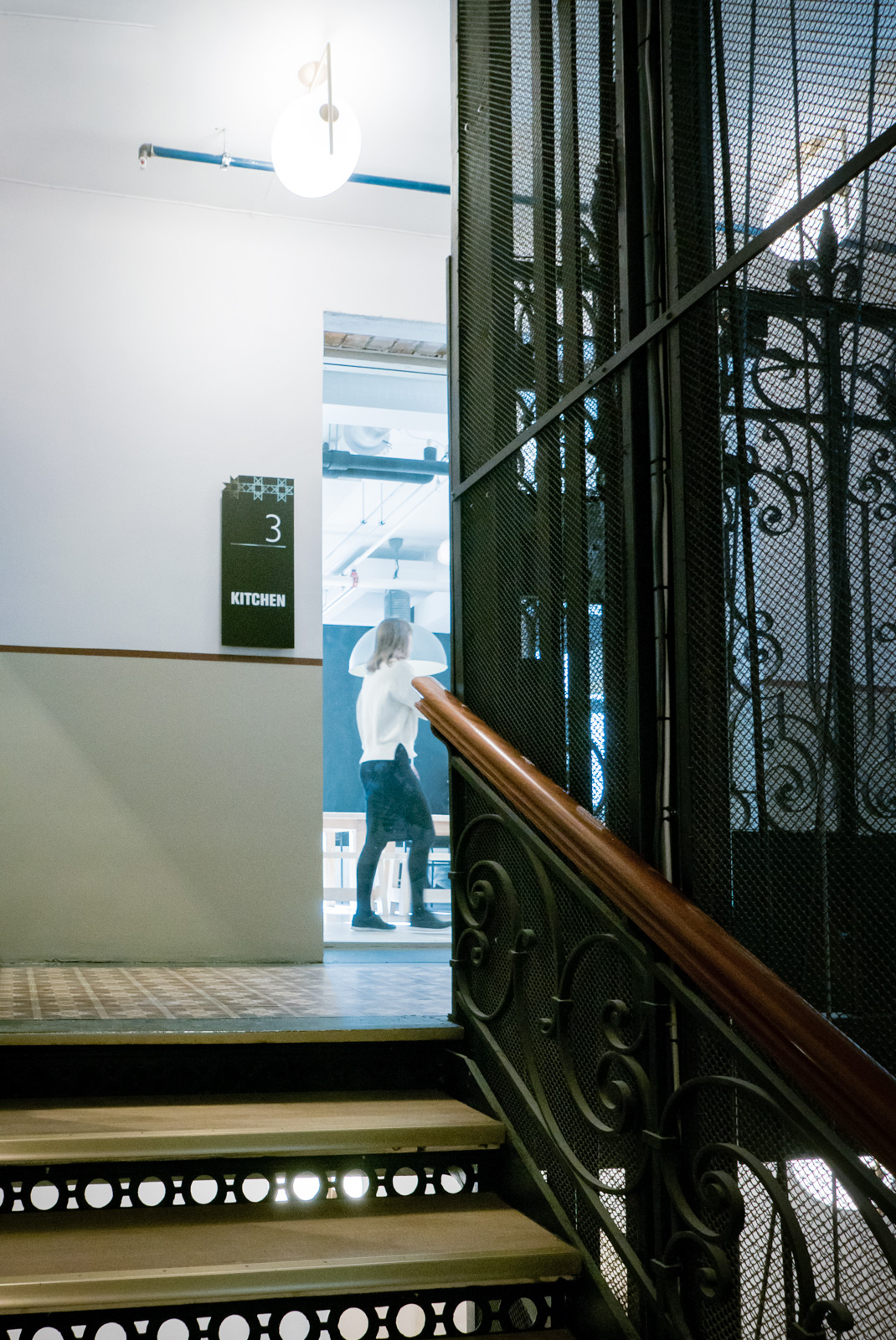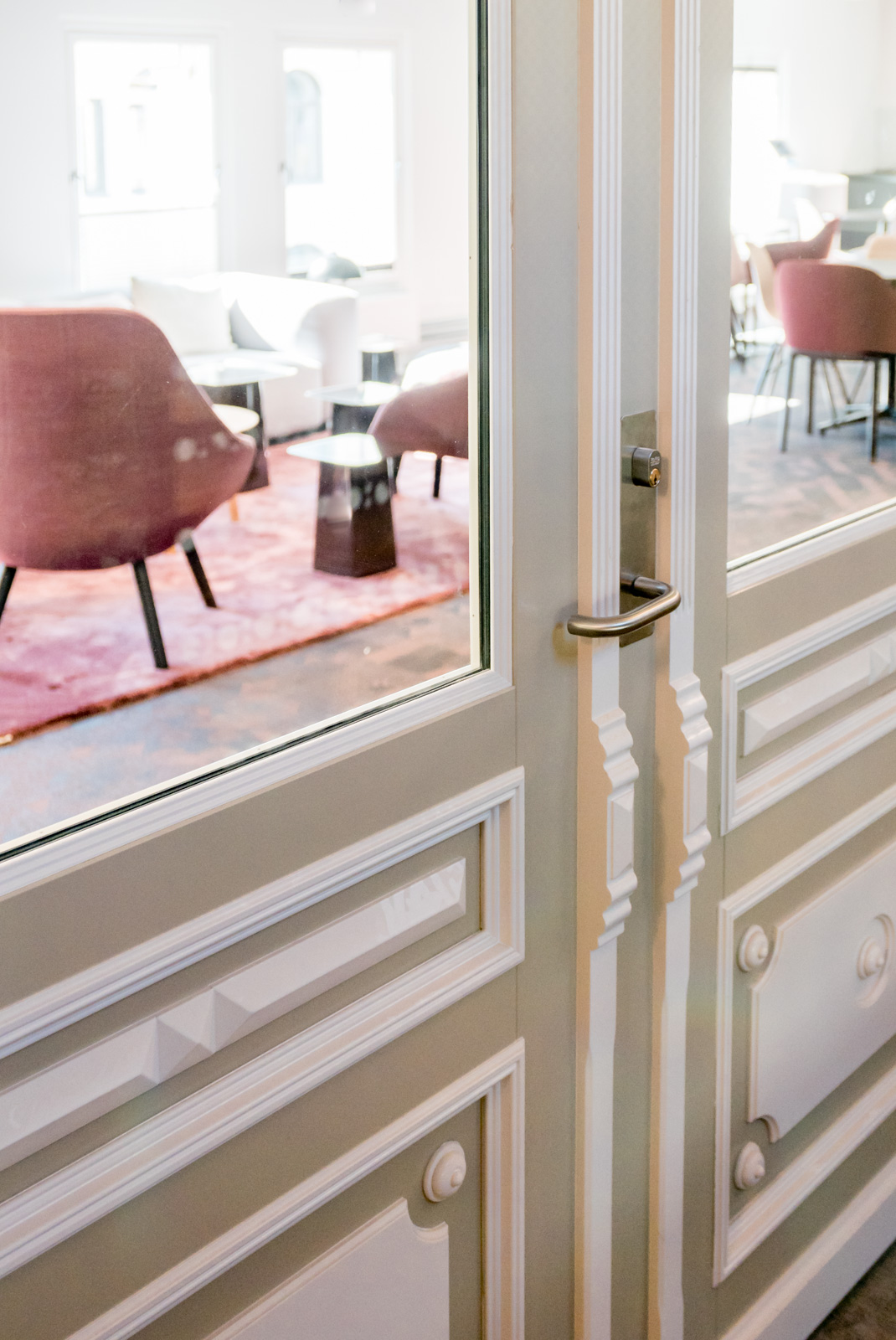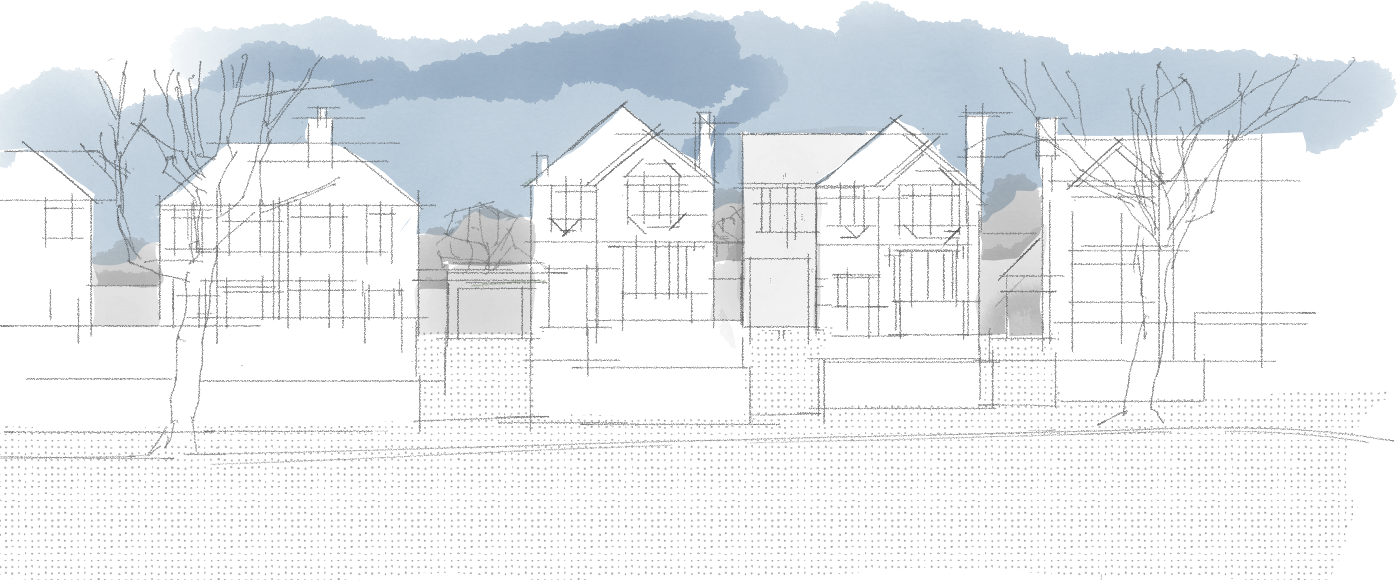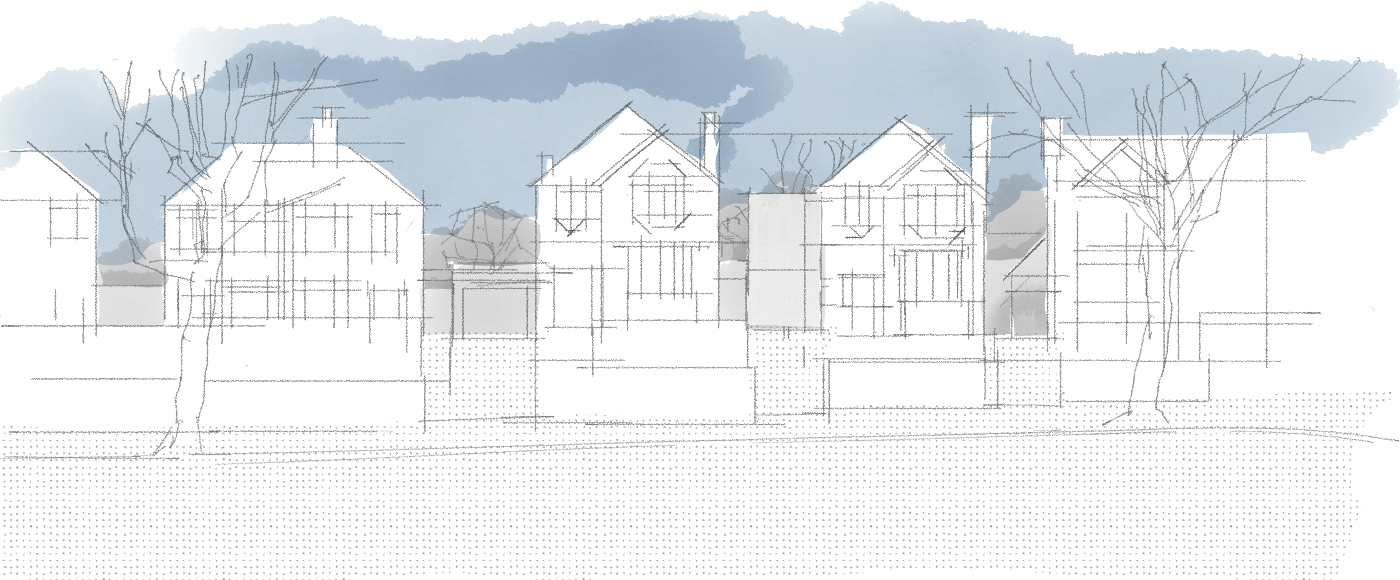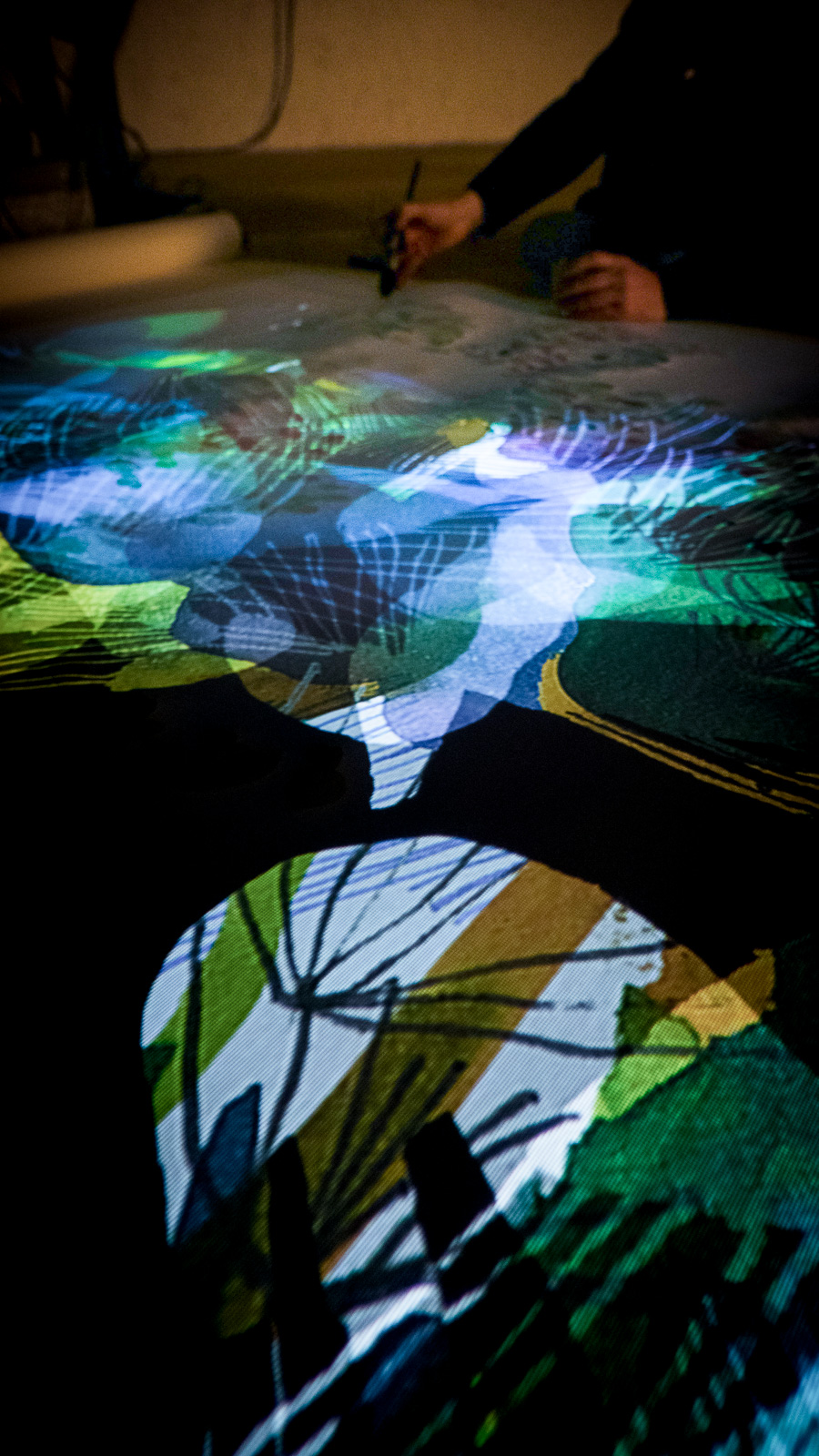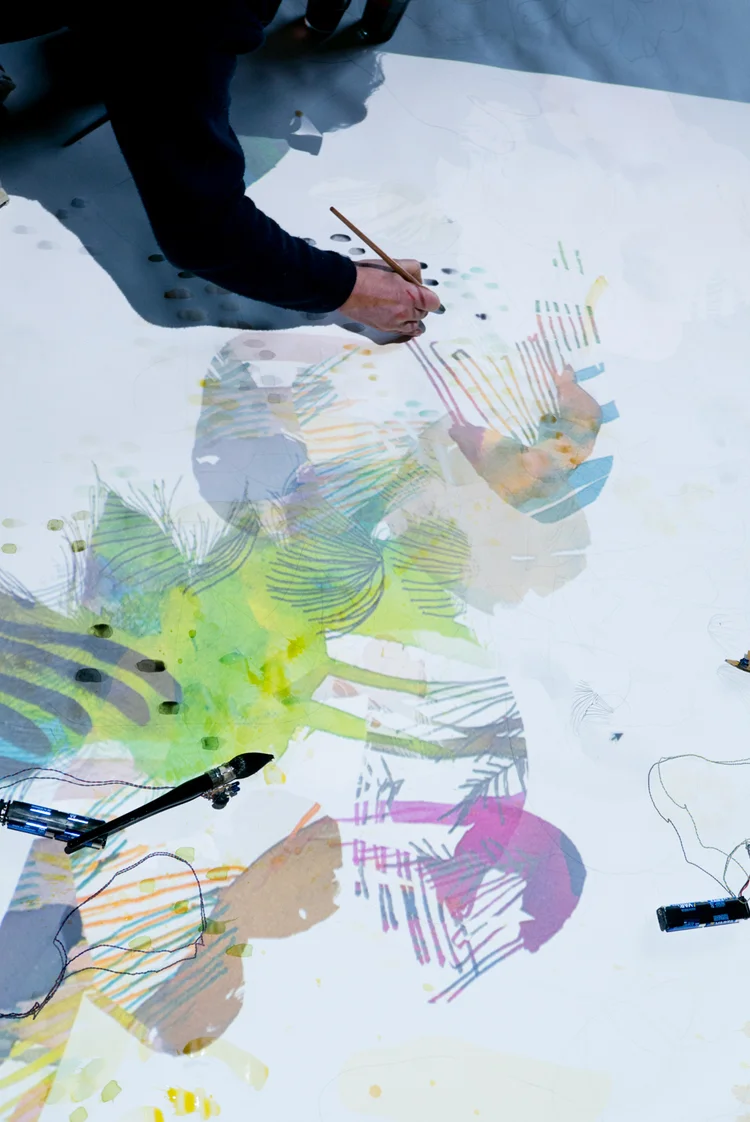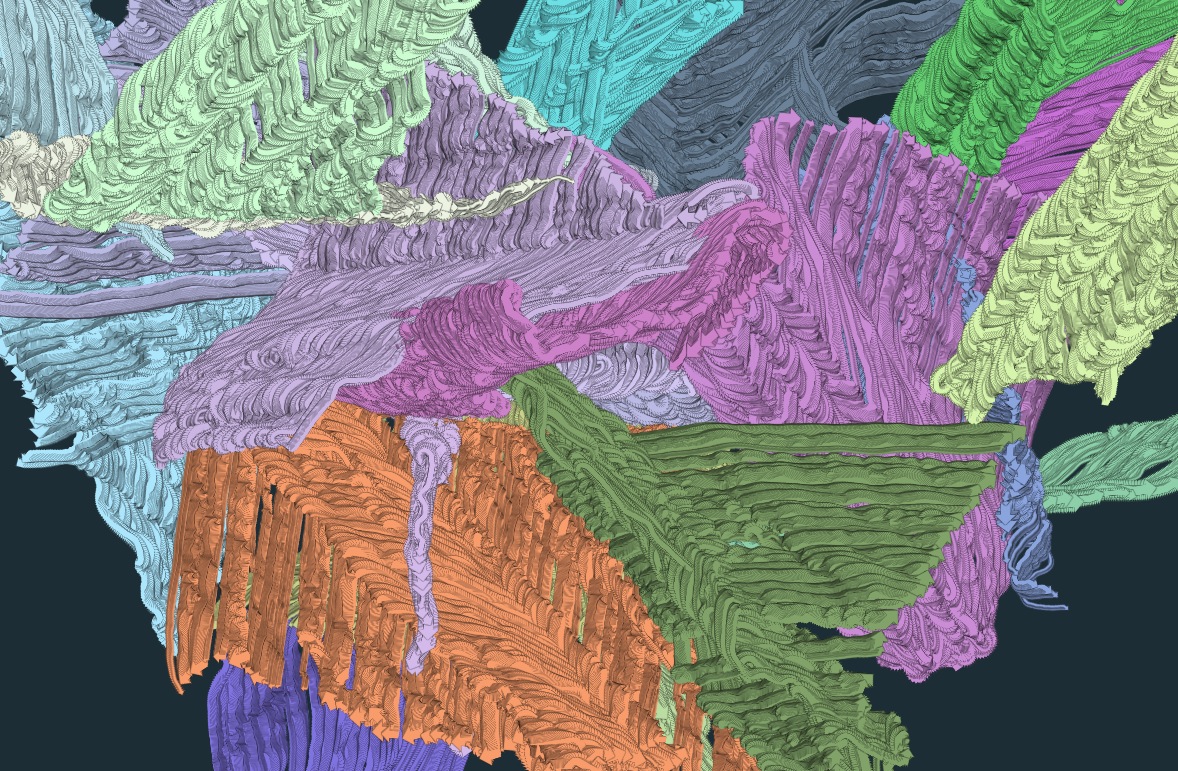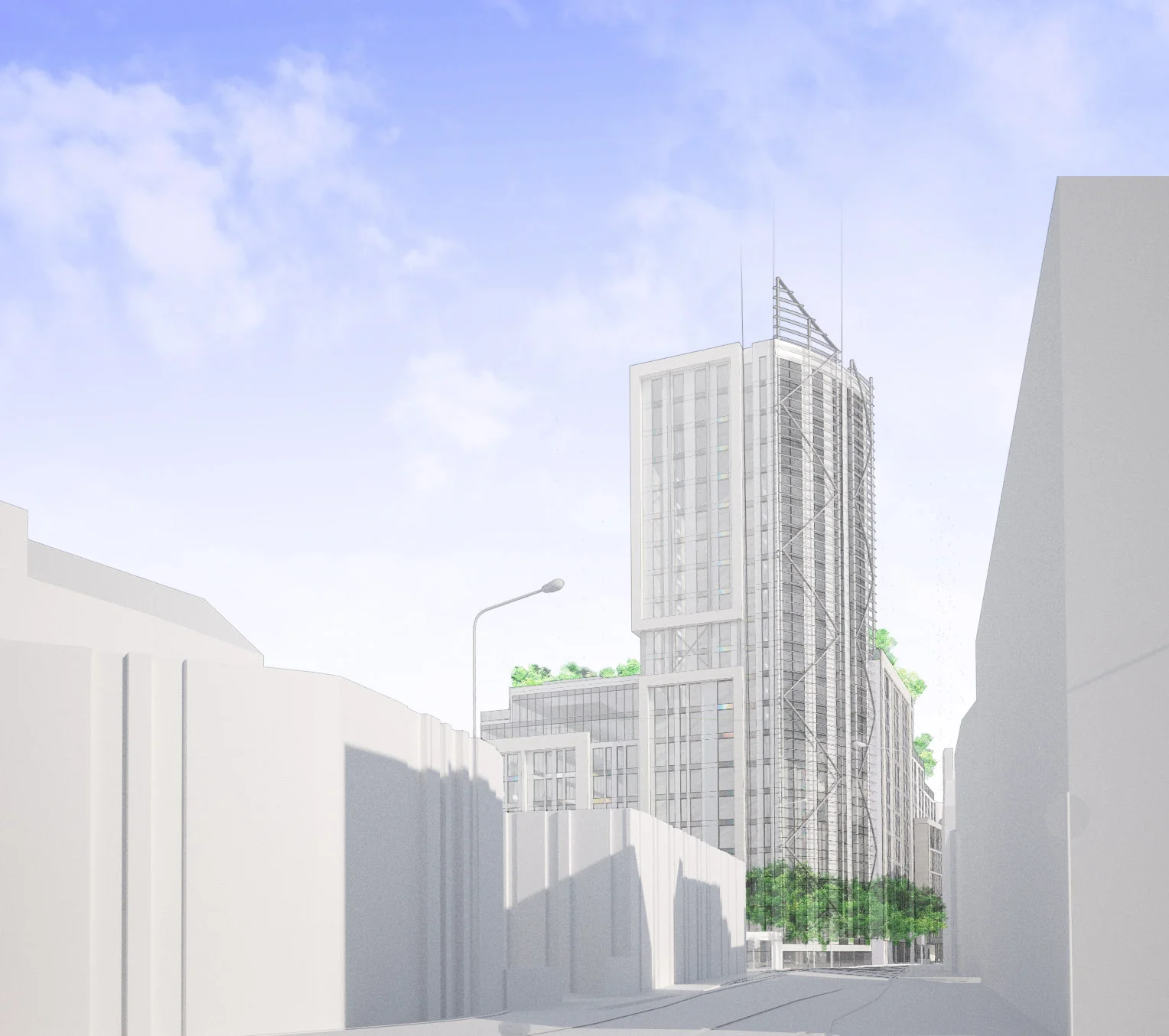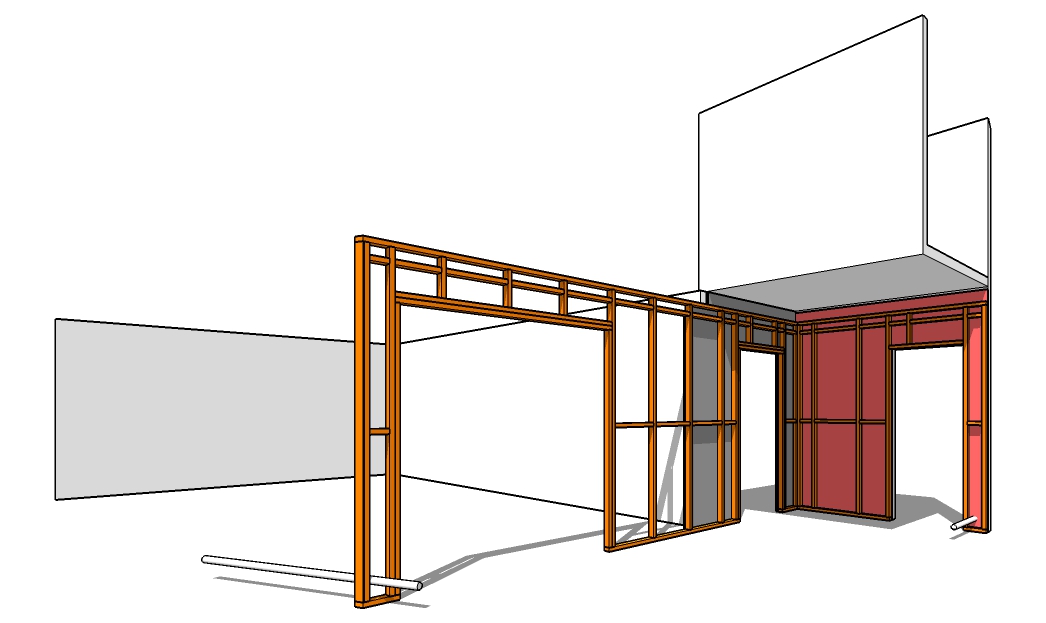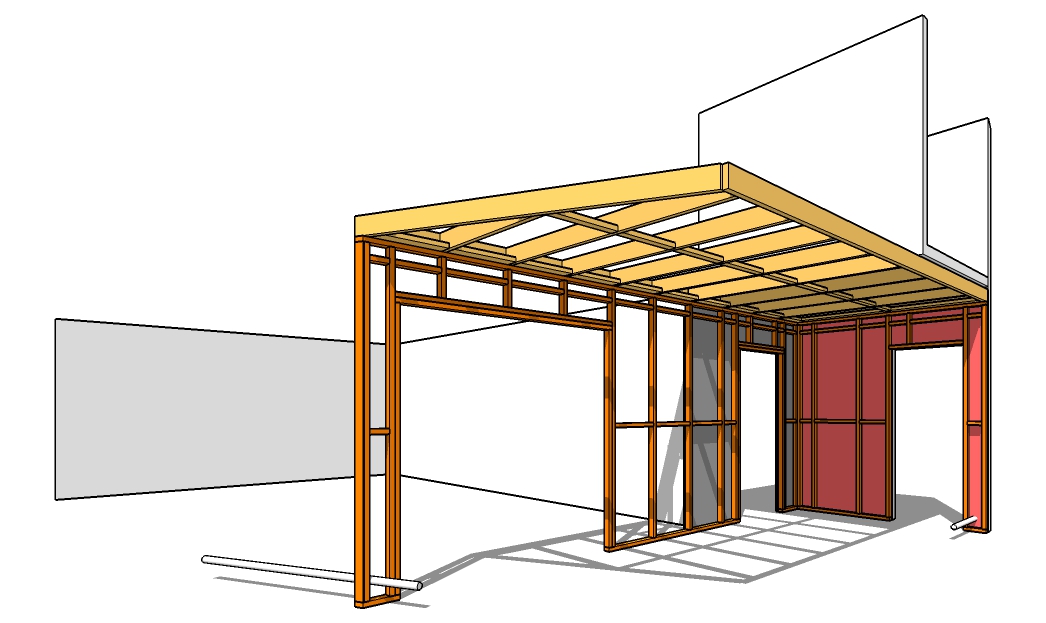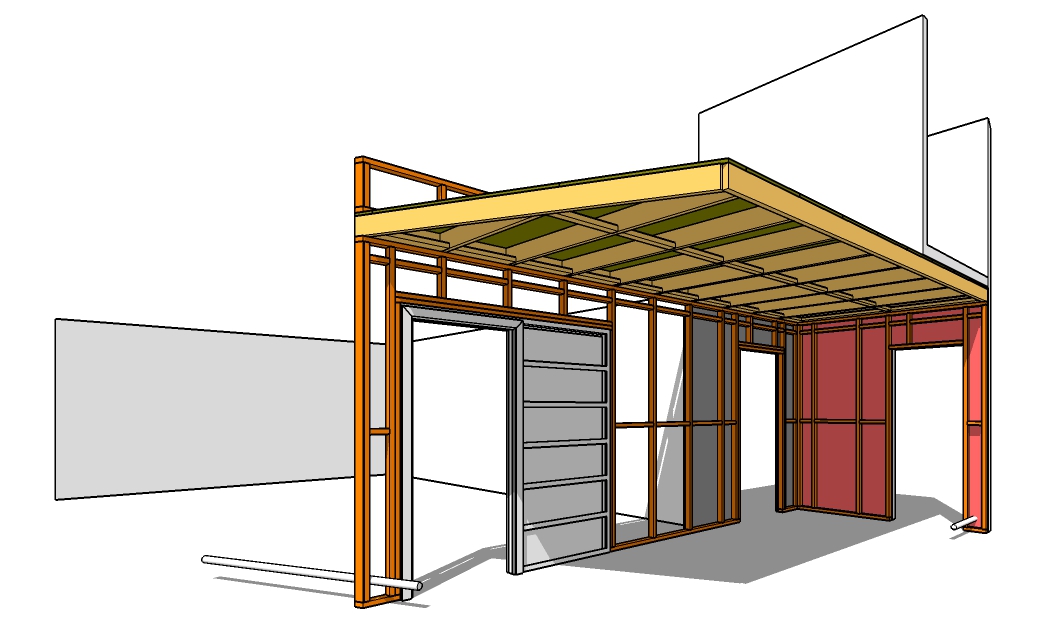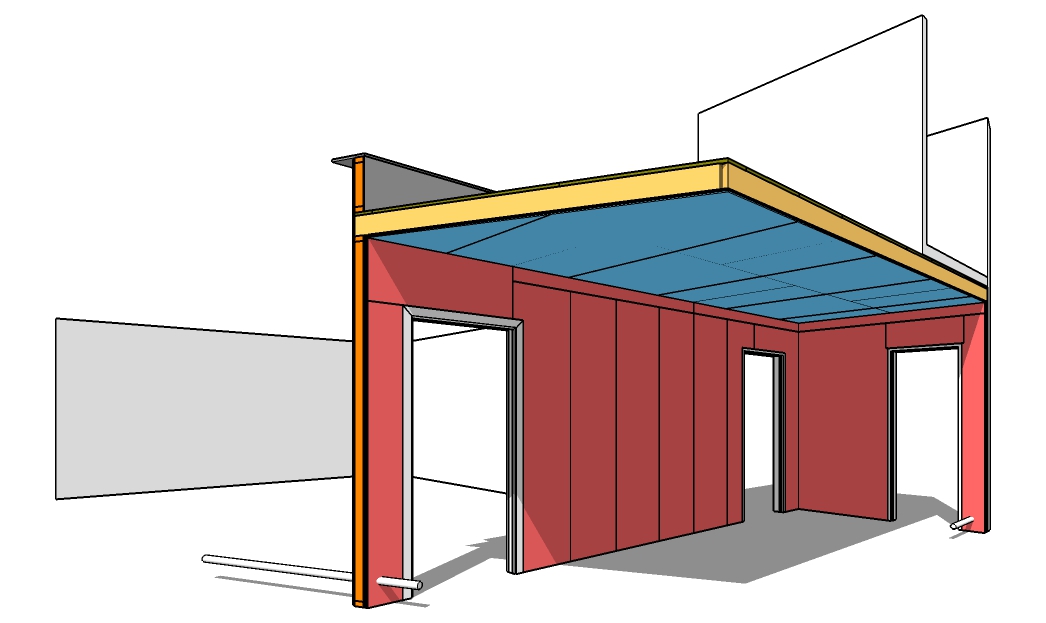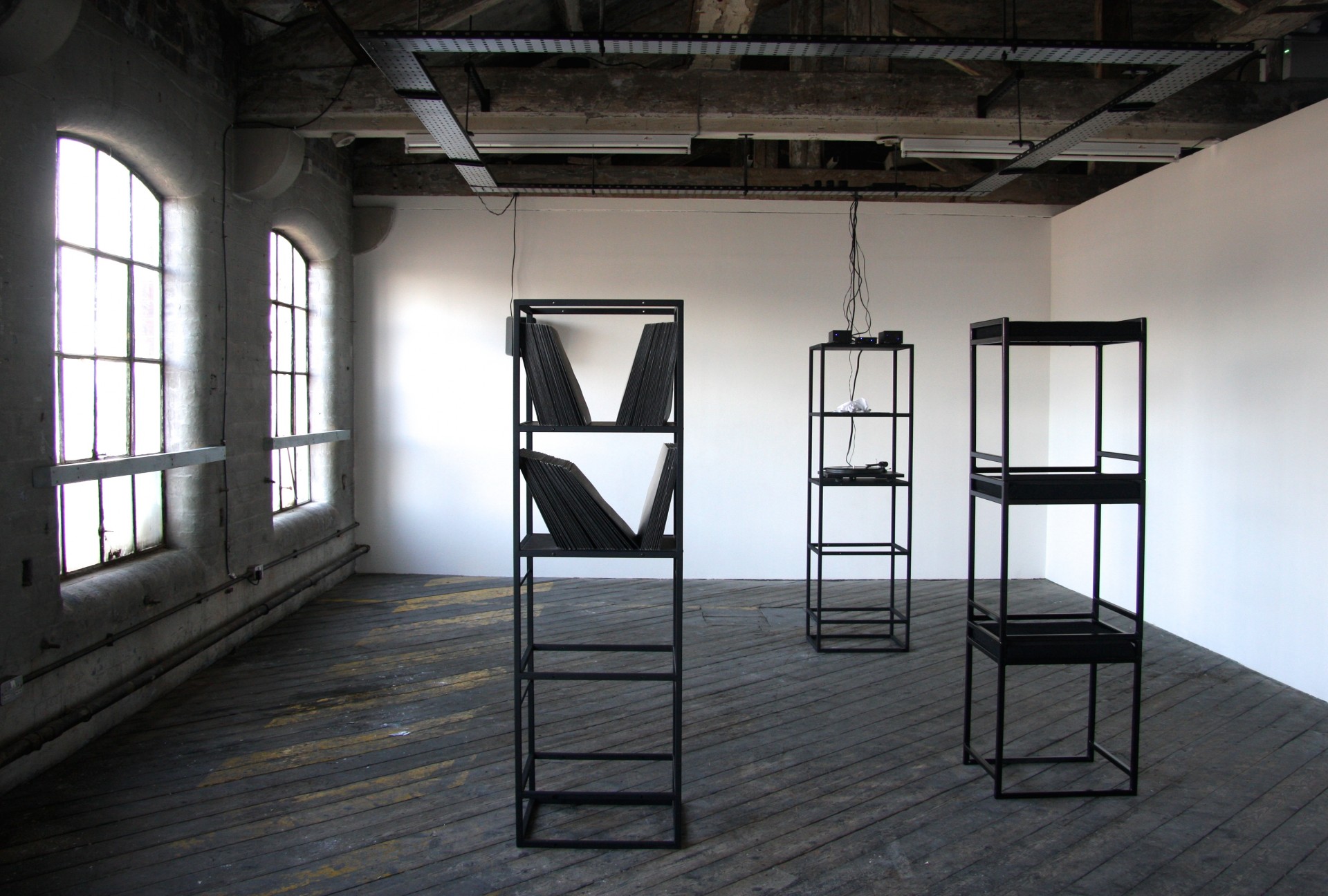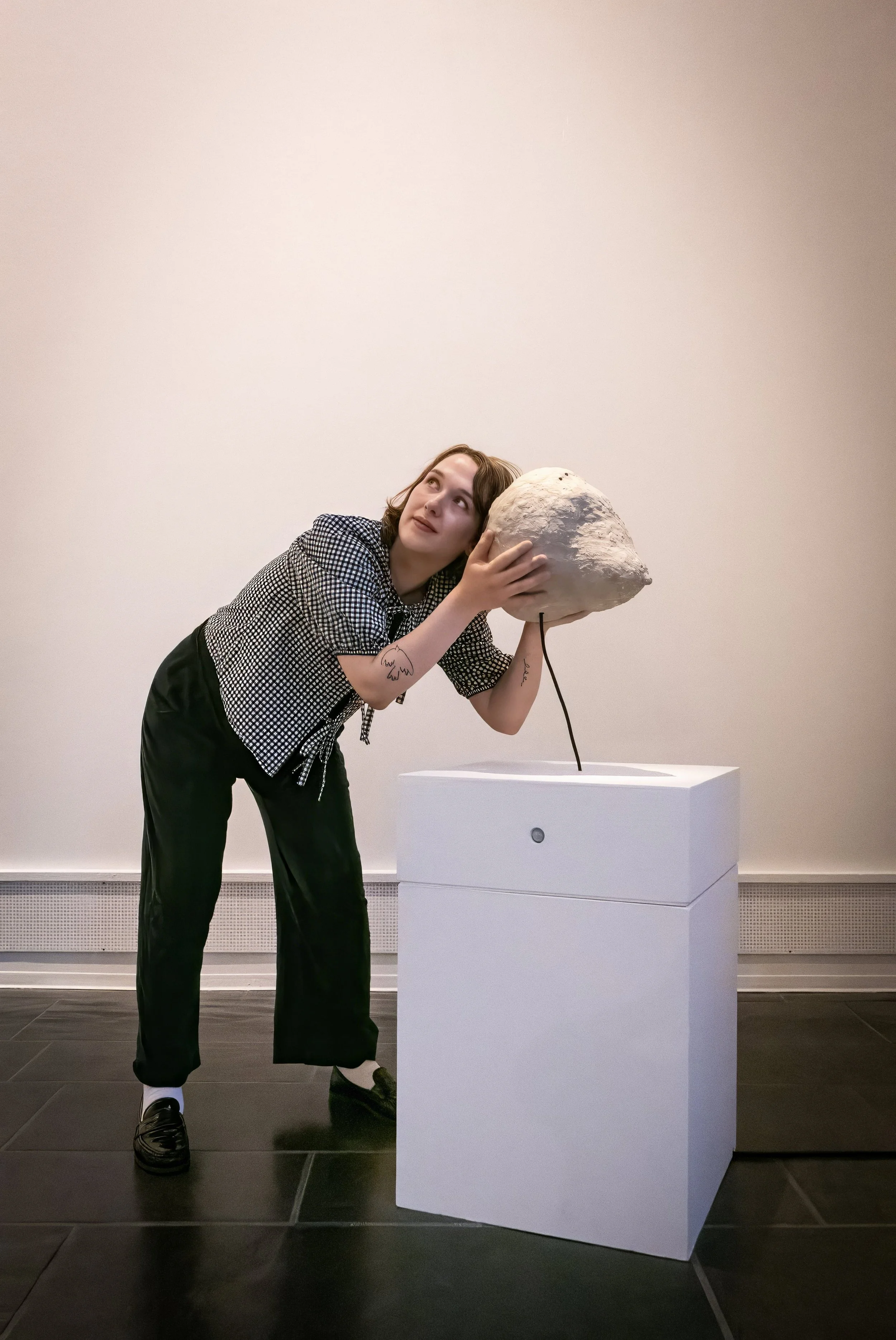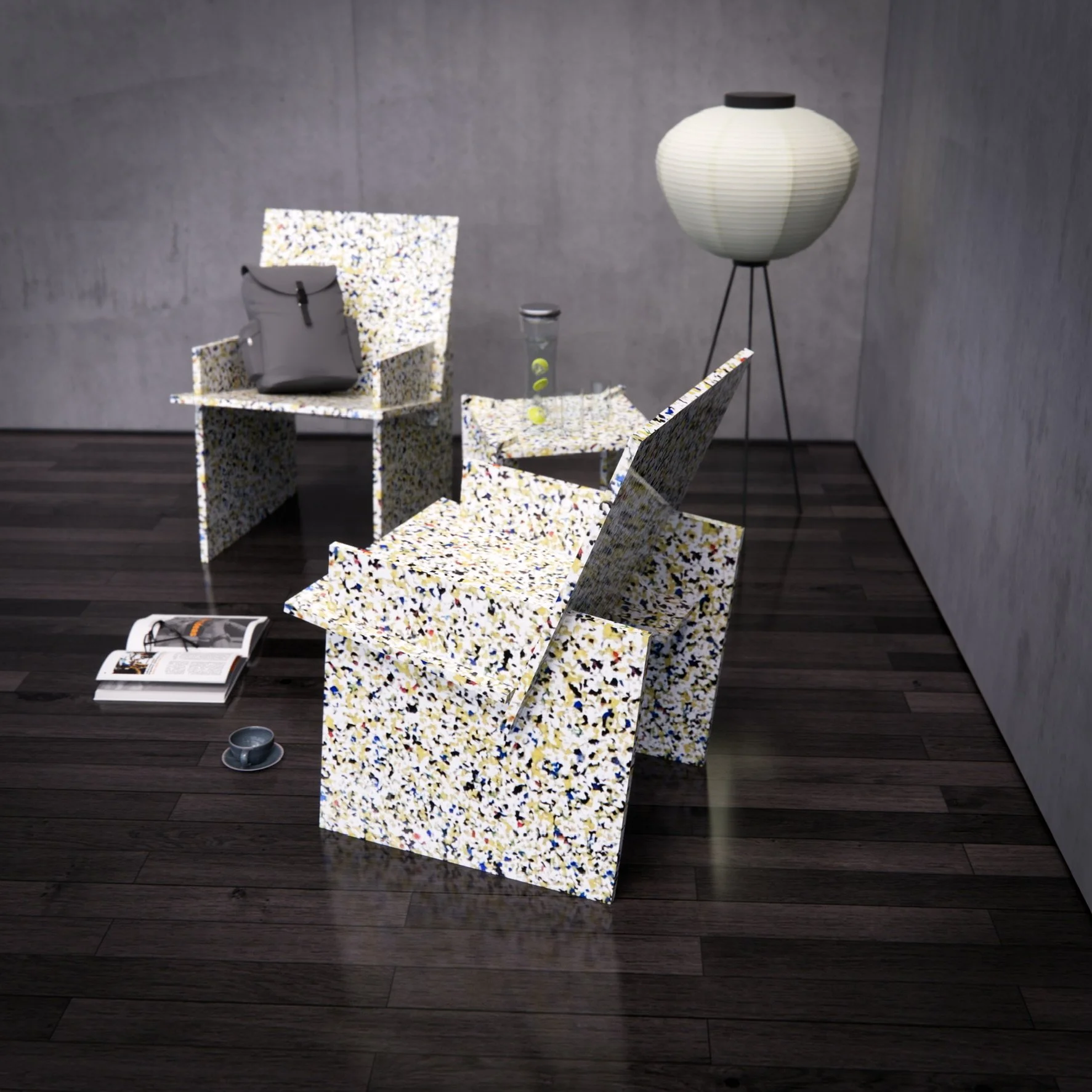A photoshoot of Kubik's latest interior design, on Oslo's riverside.
Portfolio project
Mission Control: an experimental hairy micro-office
Nicknamed "Mission Control", our broom-clad micro-office is an exercise in teleportation, designed to take us from the everyday hurly burly to a another world — one of calm, quiet and focus.
The inception of Mission Control
Our UK office was a home office — not squeezed in to a back bedroom but occupying a large ground floor room with direct access to the main entrance and the garden. For some years this served us well, but the arrival of children led inevitably to a loss of separation. As any home-working architect will testify, the room with all the paper and colouring pens is a kid magnet!
To some extent, the injection of informality improved things — collaborations became looser, more relaxed and more creative — but we were left with the need for a ‘cave’ to complement our increasingly lively ‘commons’.
Our working practices have always involved two very distinct modes. The first is highly collaborative and semi-structured, requiring large surfaces, space and materials for analogue production of drawings and models. The second, as a counterpoint, requires periods of immersion in focussed digital design and production work. Our existing home office provided ideal conditions for the former, but creating the conditions for the latter was always extremely difficult.
The new office matches the exact volume and footprint of this old shed
Crafting a solution
In the garden was glazed shed, built by the previous owner from repurposed corrugated iron, old windows, offcuts of vinyl and pieces of timber. Rickety in the extreme, we nevertheless blessed it with the name “Mission Control” because it was a great place to retreat to when setting off fireworks on bonfire night.
We decided the replacement for this shed would become our garden office.
The rise of the garden office has been met by a multitude of packaged solutions, and some truly wonderful bespoke designs. But nothing we could find in the market met our slightly odd needs.
We also felt the urge to make, at 1:1 scale and with our own hands, something that we had designed from scratch. So we decided to embark on a highly personal journey into design and build.
We designed Mission Control as a sort of antithesis of "the contemplation space with landscape views and flowing inside-outside space". We needed a cell, removed from physical context and worldly distraction, where we could retreat to immerse ourselves in brain work.
Our intention was that the building should create three totally separate experiences: an enigmatic exterior, a serene interior and a ceremonial commute to work...
An inscrutable box in the garden
Without any visible door or window the outer facades are entirely clad in natural coco-fibre broom heads: details and junctions are largely concealed, as the broom bristles interlock to provide a continuous and visually diffuse surface. Thus giving no clue as to its status as occupied or empty, the structure existing merely as an object of intrigue.
This is a reverse Tardis: much smaller on the inside than it appears from the outside. The difference in volumes results from the simple shed-like pitched roof hidden behind the parapet. The polycarbonate surface of the roof only pops through the brush cladding to divert — yet eliminates familiar details like fascias and gutters, which would make the box readable as an archetypal shed or garden office.
The mysterious object, as seen from our collaborative office space
Corner detail of the coco-fibre broom cladding
One of the two focussed workstation inside Mission Control
A serene enclosure
The space within is a comfortable and calm isolation chamber for undisturbed concentration. Two back-to-back desks are nested under the low ceilings, reminiscent of the containment created by the sloping ceiling of an artist’s garret.
Interior walls and ceilings are clad with whitewashed plywood, which adds to the calm and natural feeling environment. The breathable walls, wrapped with sheep’s wool insulation, create a healthy internal environment that is easily heated by body warmth and waste heat from computers.
Daylight and ventilation are provided by a single hidden skylight that perforates through the reflective roof surface.
View into the garden through the open sliding door, clad in brooms
A ceremonial commute
Commuting to work in Mission Control is an important symbolic process: the full experience of ‘going to work’ is here in condensed and enhanced form.
Leaving the house, and travelling the 4 metre journey to the door of the office, provides just enough time to calm and focus.
Entering the building requires interaction: finding the ‘secret panel’ broom head, sliding back the heavy screen door and pushing through the solid leaf behind...
This is a little ritual that requires concentration and creates distance from whatever else is on your mind. As the door clunks shut behind you, the box seals itself and the separation is complete. Let focus begin.
The boom cladding, momentarily shifted to reveal the space within
How to enter our broom-clad office...
Update: Mission Control has been featured on architecture magazines and websites around the world, including ArchDaily, designboom, TreeHugger, New Atlas, inHabitat and Dwell.
Portfolio project
Between a house and a cliff
The staircase/treehouse, dovetailing the different outdoor spaces, as seen from the garden entrance
For this small landscaping project, we were approached by our clients who had just bought and refurbished a house overlooking Østensjø, a large lake on the outskirts of Oslo.
Located on an elevated spot, the house and its west terraces enjoyed wonderful open views to the neighbouring lake. As a counterpoint, the rest of the outdoor spaces were tucked on a very tight site, terraced over three different levels and had been neglected in the recent years. A 8-metre high cliff backed the property to the east, overgrown with wild vines and bergenias, creating a lush cascade of vegetation and rocks.
Our client asked us to outline a strategy for making the best use of the tight exterior spaces, spread over three terraces, and organise them so that both adult activities and children play could blend together harmoniously.
The “cliff” of vegetation at the back of the property, with its lush vegetation cascading down the rocks.
Carefully analysing the existing opportunities offered by this intricate site, we designed a string of private and social places around the house, each with its unique feeling — from serene and secluded to social and vibrant— articulated by a central winding stair that doubled as a playful “tree house”.
We will be following up the work on site with our clients, impatiently awaiting the children’s feedback on their new playhouse! In the meantime, here are a few of drawings from our design process.
Design broom!
I have just returned from England, where Tom and I completed our latest self-build creation. Here is a little video teaser, with more photos coming soon...
Photography: Kubik's Nedre slottsgata
A new photoshoot forKubik Interiør Arkitekter: a newly redesigned staircase in Oslo's city centre.
Portfolio project
A sensitive contemporary extension
How to extend a 1930s 'Arts and Crafts' style detached house? One approach would be to mimic the original building, but that's not always the most sensitive or responsive solution.
The proposed extension takes a back seat to the original house
Our clients asked us to extend their house over a dilapidated single storey 'lean-to' garage, to provide a couple of new bedrooms. They also needed more ground floor space to connect properly with their garden.
Looking at the street scene, it was immediately clear that development pattern was characterised by detached houses with relatively low-key side extensions, containing garages, porches and sheds. To extend with a typical two-storey pitched-roof building would change this pattern and detract from the prominence of the 1930s house. Instead we proposed a subservient, low pitched roof that would sit below the existing building's eaves and drop down into the slope of the land. This would be clad in dark-stained vertical timber boarding, reminiscent of a number of 1930s modernist buildings - a different style but still contemporary with the original.
The extension sits into the sloping site to protect neighbours' views and daylight
Having consulted neighbours and the planning officer, we carefully explained this strategy through our planning application drawings and Design and Access Statement (DAS). This latter document is often seen as a bit of a token gesture on small scale project like this, but we see it as an opportunity to explain the care we have taken in our design and the various options considered along the way.
Massing options considered during design development
We were successfully able to make a case to go against the planning officer's pre-planning advice to use a pitched roof — it was a sensible suggestion and not one we rejected out of hand, but by careful analysis of the particular setting of this building we arrived at the conclusion that in this case, a pitched roof would not be the best way to go.
The end result will be a sensitively designed contemporary extension that extends the living space and amenities of the home without impinging on the neighbours or detracting from the proud character of the original house.
Portfolio project
Ooo-Ya-Tsu, an art performance
We like to describe Ooo-Ya-Tsu as an art performance of "collaborative soundscape painting", exploring the interaction between the gestures of classical hand-drawing, animated computer graphics and electronic music.
Ooo-Ya-Tsu is the fruit of our collaboration with visual art collective Qubo Gas and musician Olivier Durteste (a.k.a DDDxie), which took place during a series of artist residencies and public presentations between 2013 and 2016.
2hD takes part in the live public performances of Ooo-Ya-Tsu, but also developed the computer programme that drove the interaction between the drawing instruments (pencils and paint brushes), the video projection on the canvas and the musical instruments.
A short video of the performance, filmed during one of our public presentations at the multimedia festival Les Pixels, in Beauvais (France)
What is Ooo-Ya-Tsu
The layering of watercolour painting and animated video projection during one of our Ooo-Ya-Tsu performances
Taking place in the midst of the audience, three visual artists draw simultaneously on a large paper canvas laying on the floor, using pencils and watercolour brushes. Each of their actions leaves physical traces on the canvas, but also creates flurries of colours and animated collages — superimposed by a video projection that tracks their drawings movements — as well as layers of sounds and musical rhythms that build on the musical performance of the musician, sitting next to the paper canvas.
Responding to these new sound patterns, the musician himself adjusts his own live composition using electronic music instruments, creating in turn new visual effects on the paper canvas and influencing the live actions of the drawing artists.
As the performance unfolds, a complex graphical and musical dialogue develops between its different actors — each influencing the others' work, while all collaborate interactively to create a unique sound and visual landscape.
Inspired by the principles of phase music, the different rhythmic and visual layers of this landscape come in and out of focus: sometimes momentarily revealing the different musical and graphical universes that constitute them, sometimes recombining them into complex abstract patterns. Until eventually, both music and projected animations begins to evolve autonomously, continuing to shift and echo long after the performance of the actors themselves is over.
Creating Ooo-Ya-Tsu
At the centre of the Ooo-Ya-Tsu performance is a custom-made computer programme created by 2hD, using the Processing programming language. This powerful language allowed us to develop a system that allowed linking all the different aspects of the performance, combining motion tracking, video projections, interactions with physical objects and simulations of autonomous particle systems...
A video showing alternative views of the performance programme in debug mode, revealing the interactions between the graphical particles, as well as the sound phasing partition (scrolling at the bottom).
The visual aesthetic of Ooo-Ya-Tsu is based on the dream-like imagery of French art collective Qubo Gas, whose work poetically combines painstakingly intricate paintings and collage techniques, with scales ranging from miniature to architectural.
Having scanned a series of artwork they produced for the performance, we programmed the system to dynamically recombined them into an near-infinite number of different collages.
These images could then be superimposed and animated onto the paper canvas, responding to the physical ink forms drawn on the canvas during the live performance, which are analysed by the programme in real-time using infra-red cameras.
The modular aspect of the Processing language also allowed us to combine existing programming libraries to interact remotely with the musician's live performance: triggering visual events in response to certain of his composition patterns or sounds, but also playing sounds directly on his electronic instruments in response to drawing actions on the canvas.
The resulting soundtrack of the performance is a layered composition of phase-shifting abstract samples, overlapping and structuring DDDxie's live electronic music:
Details of some of the watercolour images hand-painted by Qubo Gas and used by our programme to generate the animated projections on the paper canvas.
Despite its technical complexity, we conceived Ooo-Ya-Tsu so that the technological aspects of the performance remained mostly inconspicuous, keeping the focus instead on Qubo Gas' poetical hand drawings, the materiality of the paper medium and DDDxie's layered and minimalist sound compositions.
In 2013, the Ooo-Ya-Tsu performance was awarded a production grant from the prestigious Centre National du Cinéma et de l'image animée (CNC), in France.
Ooo-Ya-Tsu's public appearances:
- 11/16: public performance at l'ASCA (Beauvais)
- 02/16: public performance at La Malterie (Lille)
- 07/15: exhibition Experiences Interactives at Pictanovo (Lille)
- 09/15: public performance at Gare Numérique (Jeumont)
- 08/14: Arte TV documentary at Le Cube (Paris)
Institutions supporting Ooo-Ya-Tsu:
The Ooo-Ya-Tsu performance was developed and produced with the support of: L'Aéronef / Le Cube / La Malterie / Pictanovo / Société Civile des Auteurs Multimédia (SCAM) / Centre National du Cinéma et de l'image animée (CNC) / La Gare Numérique
Are you an artist interested in interactive installations and performances?
Interested in hosting Ooo-Ya-Tsu for a public presentation or an artist residency?
Ooo-Ya-Tsu: video of our live performance at ASCA
Following our artist residency in France last November, we have put together this short film, based on the third public presentation of our art performance Ooo-Ya-Tsu.
(Film by Olivier Lallart & Justine Pluvinage)
Photography: UGG showroom
I have just completed another photoshoot with interior architects Kubik, this time to photograph their recent refurnishing of a showroom for the uber-trendy shoe designer UGG, in Oslo.
Communicating sketch design ideas to planners
In our latest collaboration with David Boden, of Boden Associates, we produced a series of visualisations for a twenty-story mixed-use development in central Leicester, UK. These were used as part of an on-going consultation with the local planning authorities.
While this project was still in its sketch design stage, we built and maintained a SketchUp model of the building, based on the 2D drawings (plans and elevations) produced by the design team. As the design evolved, we updated the 3D model to reflect changes and provide visual feedback to the team, allowing them to explore alternative design options and assess visual impact.
We eventually produced illustrations of the proposed building for presentation to the city planners, who had specific questions about massing and facade treatments. The challenge was to clearly illustrate the design aspects in question, while emphasising the fact that the design was still in progress.
To achieve a subtle blend of sketchiness and detail, we used a hybrid presentation technique combining photorealistic renders of our SketchUp model (using Maxwell render) with hand drawing and photography.
It's been great working with you in 2016!
We hope you've had a great year — it's certainly been an interesting one for us: from sportive challenges like kick-sled downhill world championships and charity running, to our first public art performances, further work on community development and plenty of architecture along the way.
Thanks for sticking with us and let's reconnect in 2017!
Tom, Chris and Thibaut at 2hD Architecture Workshop
Our self-builder clients share hands-on experience
“Appointing an architect has been one of the most valuable expenses of the project. I guess that it varies with the architecture practice you are working with, but for our project, 2hD have worked perfectly and have created a home totally adapted to our lifestyle and our constraints. Nothing to do with our original basic plans, nothing at all. Everything was taken into accounts: daylight, connections between the spaces, their volumes and their different levels...”
Our client building the new staircase of the converted barn, using massive oak boards sourced from a local sawmill.
With now ten years of experience as self-builder, transforming a old stone barn in Dordogne (France) into their dream home, our clients Béranger and Mélanie look back at their amazing achievements.
Over these years they have realised virtually all aspects of the building process themselves — from groundworks and water recycling system, to carpentry and furniture making. They have now decided to give back to the self-building community by sharing all their experience in a great article on their project blog (in French), touching on subjects as varied as project planning, finance and tips on how to not hurt your back on a building site...
2hD started to work as architects on this project as soon as Béranger and Mélanie purchased the run-down stone barn, back in 2006. And we have worked hand-in-hand with them ever-since: helping them define a solid project brief, developing sketch design alternatives, selecting adapted and affordable technical solutions, but also creating custom 3D models of the barn to guide them through the self-build construction process.
Amazingly attentive to details and quality, they are now proud owners of a stunning home, as well as experienced carpenters, plumbers, furniture makers and SketchUp 3D modellers! And they even received an award for their work...
Discussing the usefulness of working with architects in self-build projects, this is what our client Béranger has to say:
“In the end, even if your project is not as large as ours and does not (legally) require an architect, we strongly advise you to appoint one. You will have all the drawings, and thus a definite vision of what your home can be. And this brings a lot in terms of motivation and anticipation.”
You can read the full article on our client's project blog.
Designing self-build projects for artists
A recent project at One Thoresby Street artists studios and gallery gave us a chance to develop new techniques for designing with self-builders.
Artists at the One Thoresby Street gallery, building our design themselves
As part of a longstanding relationship with the artists at One Thoresby Street (OTS), we were asked to design a lobby space for the top-floor Attic Gallery. This would sort out circulation between the gallery and studio spaces and provide a vital fire safety feature by separating the occupied space from the access stairwell. Unusually, the lobby would be built entirely by the artists themselves.
We approached the project through a careful survey of the existing building and designed the lobby to create a great experience for visitors as they approached up the stairwell. A sliding fire door, held open on electronic sensors linked to the fire alarm system ensures that movement and views through are eased. The height of the lobby is reduced to contrast with the tall gallery space, which also minimises the materials used and creates a storage and projection deck overhead.
High technical standards had to be met in the project to create a fire resistant construction, the budget was tight for materials and the building team (skilled makers but not construction professionals) needed to have excellent clarity over the build process.
This put huge demands on the communication of technical information, so we took an approach more normally found in larger scale projects - we created a 'Building Information Model'. This was a CAD model showing every structural member, board and component, organised to give the artists a coordinated picture of the materials to order, the dimensions for cutting, the assembly sequence and the spatial relationship between every item in the final assembly. We then lent the group a laptop with the CAD model installed so that they could take the information directly off it on site.
The build proceeded smoothly with a tiny number of requests for additional information, wastage of materials was kept to a minimum and the end result is a happy self build client, an effective adaptation and an safer, better Attic Gallery space at OTS.
Can architectural skills help save a local landmark?
Tom and Chris have been working with a 'community alliance' in Sneinton, Nottingham. A local historic building, much loved by the community, is under threat of demolition. We've offered our community engagement and architectural skills to "dOSH" (Development of the Old School Hall) which has formed to find a sustainable use for the site.
Bringing the community together to share knowledge and ideas.
The Old School Hall building dates from the 1840s. Originally a school standing on the boundary between Sneinton and Nottingham, the building served generations of pupils. When in the 1960s a new modern school was opened just up the road, the Old School Hall community centre was created on the site. Many local residents have positive associations with the building as both a school and community centre, so the news that it had closed, and would face demolition, came as a significant blow.
Through his work with Sneinton Neighbourhood Forum, meeting with local Councillors, residents and community groups, Tom helped to arrange a public meeting to bring together all interested people and groups. The strategy was to ensure good information was in the public realm about the threat faced by the building, and to find out whether there was an appetite to try and save the building or to reuse the site for another purpose. The Council had revealed that the building would require a significant investment to make it safe for use and for refurbishment. Despite this, a strong will was identified to try and find a new use for the building, retaining some element of community access whilst securing a viable income stream to maintain the building for the future
Tom attended these meetings and helped the group to come together, structured appropriately as an 'Unincorporated Association' with a clearly defined remit: "To help save the Old School Hall by meeting to discuss feasibility and develop ideas arising from the community to create a business plan". He also researched the history of the site, created posters, spread the word through social media and set up a website and blog for the dOSH group: www.doshsneinton.org.uk
By happy coincidence at this point, Chris was putting the word out to community groups, offering free consultancy as part of his research at Nottingham Trent University. He has been advising the dOSH group on understanding the existing building, seeking advice on the structural stability and condition including liaising with structural engineers and reviewing existing condition reports.
The challenges facing the group are extensive, but the collaborative approach we have helped to foster, in getting organised and understanding both problems and visions, has started things off on the right foot.
The groups represented in dOSH include:
- Sneinton Neighbourhood Forum
- The Renewal Trust
- Sneinton Alchemy
- WIND (Windmill Improvement for Neighbourhood Development)
- The Old School Hall Community Association and management committee
- Nottingham Lindy Hop
- Nottingham Trent University School of Architecture Design & Built Environment
Ooo-Ya-Tsu at digital art festival Les Pixels
L'Association Culturelle Argentine (ASCA) has invited us to present our art performance Ooo-Ya-Tsu as part of the 8th edition of their digital art festival Les Pixels, on Thursday 24th November 2016, in Beauvais (France).
In the days preceding the performance, we will be also running workshops with local schools and associations, creating a large hand-painted and digital fresco for the festival.
After La Gare Numérique and La Malterie, this will be the third public presentation of our live performance Ooo-Ya-Tsu, an art collaboration with art collective Qubo Gas and musician Olivier Durteste..

